Menus
- Terribly beautiful
- The unique piece is tailored to Tobias’ needs
- “Kamikaze” stands for perfect craftsmanship and a great attention to detail
- There for everyone
- Conversion information
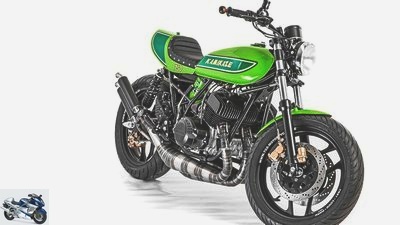
Christian Haasz
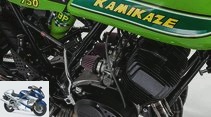
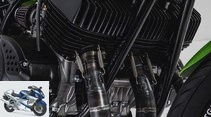
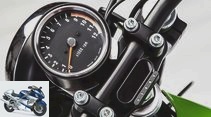
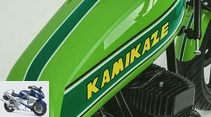
12th photos
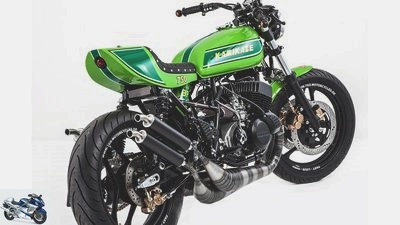
Haasz
1/12
Most of the time, the plans for Tobias Guckel’s spectacular conversions have been parked in his head for a long time before they are implemented. This was also the case with the “Kamikaze” project, whose martial name was already fixed in the first mind games in 2008.
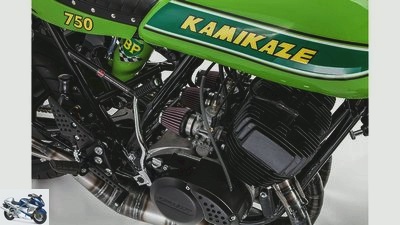
Haasz
2/12
Everything is different: the rear frame was shortened and reinforced, the footrest mountings moved, the engine completely overhauled and the oil tank built from an exhaust jacket.
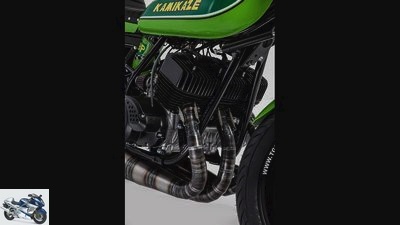
Haasz
3/12
The aluminum swingarm, borrowed from a 1100 Suzuki, as well as the Jolly Moto exhaust system, as well as the fork, wheels and brakes contributed by a Suzuki GSX-R 750 from the first series, had to be lavishly adapted. By the way, deliberately because the 70s freak associates a lot of memories with this fully disguised 80s super sports car – the GSX-R was Tobias ‘first motorcycle.
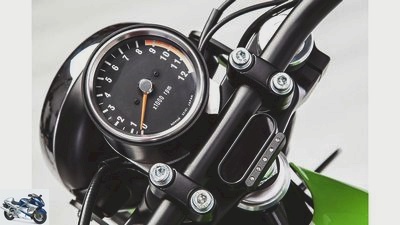
Haasz
4/12
Original tachometer with digital speedometer.
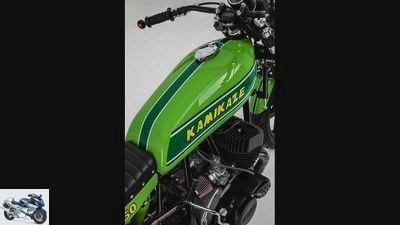
Haasz
5/12
Short and slim: The tank comes from a Kawa KH 500.
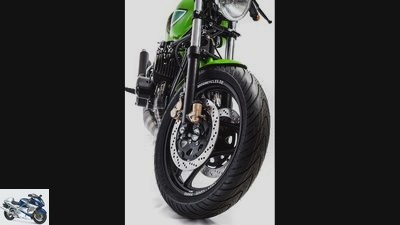
Haasz
6/12
A radical one-off, wildly and aggressively styled with the highest degree of individuality.
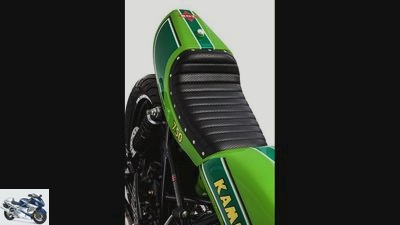
Haasz
7/12
Here you would like to take a seat: The stylish hump was made from sheet steel, the rear light was integrated into it.
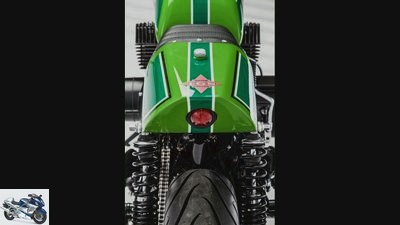
Haasz
8/12
Reduced to the bare essentials, the visual focus moves to the center. The fork, 18-inch wheels and brakes of a Suzuki GSX-R 750 have been adjusted so that they blend in harmoniously with the picture.
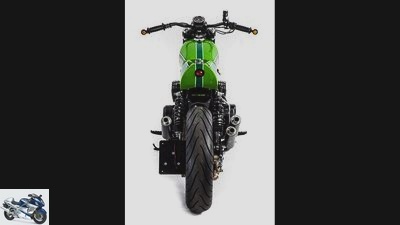
Haasz
9/12
From this perspective you can see the beautiful curves of the tank and hump. With mirrors and splash protection there is even the blessing of the TÜV.
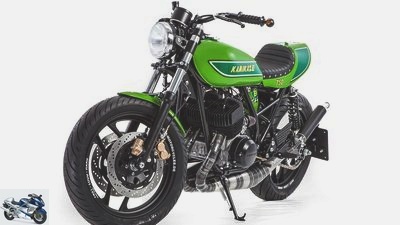
Haasz
10/12
The chassis was first freed from the rear frame and all unnecessary brackets. The hump is a proprietary design.
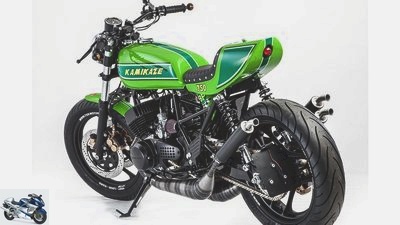
Haasz
11/12
“Kamikaze” stands for perfect craftsmanship and great attention to detail.
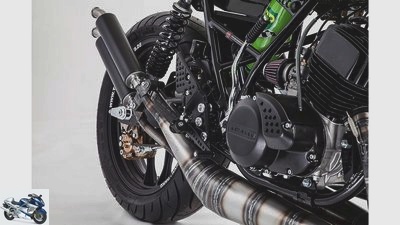
Haasz
12/12
Tobias built the “Kamikaze” just for himself, it is unique. There is of course no lack of ideas for similar conversions. After all, he works today where his childhood shaped him.
In the studio: Kawasaki H2 self-made
Terribly beautiful
Content of
At some point the question arose: How can you redesign a Kawasaki 750 H2 so that it lives up to its legendary reputation? Tobias Guckel has found the answer. And put a breathtaking motorcycle on its wheels.
D.he man can’t help it. Growing up in the magical triangle of rural Rappenhof, consisting of the grandfather’s Deltin petrol station, the workshop next to it and the newspaper rack with the motorsport magazines in grandma’s small shop, Tobias Guckel simply had to turn into a “Petrol Head" will. “A totally contaminated person", as the 40-year-old master motorcycle mechanic admits with a grin. Someone who, as a little boy, counted the manifolds of every fueling motorcycle and saved the special sound of the three-cylinder two-stroke Kawas and the Japanese four-cylinder on his hard drive forever.
Buy complete article
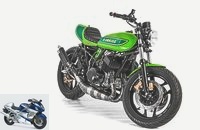
In the studio: Kawasaki H2 self-made
Terribly beautiful
Kawasaki 750 H2 specified. Although Tobias chose this term with a twinkle in his eye, because the cheerful Bavarian has nothing to do with life-negating action, whether on or off the road. More like – how can it be otherwise – with the classic Kawasaki characters, which are also found on the tank of the “Kamikaze" the color inspired by the traditional BP logo from the – of course – 1970s.
The unique piece is tailored to Tobias’ needs
Haasz
A radical one-off, wildly and aggressively styled with the highest degree of individuality.
The fuel tank itself comes from a Kawasaki KH 500, which Tobias, like almost all the other components, has purposely acquired over the years for this conversion project. Because the starting position was very clear: at the beginning of construction last autumn, there was no more than a frame and a motor whose crankshaft no longer turned. All of the components built into the “Kamikaze” had to be either made by the company, freshly overhauled or laboriously reworked.
Which suited Tobias to the extent that he wanted to tailor this unique piece to his needs anyway. So the chassis was freed from the rear frame and all unnecessary brackets. Tobias then adapted the footrest mounts to his body size, and welded new brackets to the shortened and reinforced rear frame for the exhaust, side stand and electrical components. The engine was also completely revised. The crankshaft, cylinder, piston, bearings, some transmission gears and the clutch are new, as is the self-configured wiring harness.
In-house designs are still the hump made from one millimeter thick sheet steel with the invisible screw connections and the oil tank with level indicator and shut-off valve, which was a Supertrapp silencer in its former life. Not to forget the countless sockets made of aluminum or stainless steel or the lower triple clamp with specially manufactured yoke. The aluminum swingarm, borrowed from a 1100 Suzuki, as well as the Jolly Moto exhaust system, as well as the fork, wheels and brakes contributed by a Suzuki GSX-R 750 of the first series, had to be lavishly adapted.
“Kamikaze” stands for perfect craftsmanship and a great attention to detail
Haasz
Everything is different: the rear frame was shortened and reinforced, the footrest mountings moved, the engine completely overhauled and the oil tank built from an exhaust jacket.
By the way, quite deliberately because the 70s freak associates a lot of memories with this fully disguised 80s super sports car – the GSX-R was Tobias ‘first motorcycle. In addition, the 18-inch model of the Suzuki, which is not exaggeratedly wide, harmonizes perfectly with the “Kamikaze”, which, according to its builder, should “look as if a tuner had taken it on in the 1970s”. In addition, the floating double disc brake with the freshly overhauled four-piston calipers fits perfectly with Tobias Guckel’s philosophy.
Optimizing is also at the top of the list for true-to-original restorations, if the customer so wishes. “If the driving pleasure can be significantly improved by installing a double disc brake or adjustable spring struts, why shouldn’t I do it?”, He refuses the keepers of the Grail of absolute originality. Nevertheless, a wild mix of styles will never leave the Bavarian workshop. Especially not with the “Kamikaze” project, which is completely tailored to Tobias. Here, too, the goal was to create a coherent overall composition with a highly individual style despite the deliberately radical renovation. And Tobias and his five colleagues at TGS Motorcycles have succeeded perfectly.
Haasz
Most of the time, the plans for Tobias Guckel’s spectacular conversions have been parked in his head for a long time before they are implemented.
With a lot of effort and attention to detail – with the blessing of the TÜV, by the way – a motorcycle that looks fast, wild and aggressive was put on its wheels within three months. And thus embodies everything that has made the legendary reputation of the Kawasaki H2 for generations.
Tobias built the “Kamikaze” just for himself, it is unique. There is of course no lack of ideas for similar conversions. After all, he works today where his childhood shaped him – in the magic triangle of Rappenhof.
There for everyone
Haasz
Controls the fortunes of TGS Motorcycles: Tobias Guckel with his “Kamikaze”.
Tobias Guckel’s company TGS has been located in Rappenhof in the southeastern Bavarian Forest since 1998 – exactly on the property of his grandfather that shaped his childhood.
Here five specialists take care of motorcycles of all brands. The range includes regular maintenance work, repairs, tuning, modifications and both partial and complete restorations. The Japanese classics and youngtimers of the 1970s, 80s and 90s are particularly important to Tobias and his team, for which TGS also offers numerous technical improvements that can be implemented not least thanks to the constantly growing machine park in-house. Of course, this also benefits the construction of custom bikes, which has become an increasingly important business area for Tobias and his men. Numerous national and international victories in the relevant competitions testify to the creativity of the Rappenhofer Edelschmiede, which even operates its own parts production and offers custom-made products for customers. With his own constructions like the “Kamikaze”, Tobias wants to show what is possible – and at the same time inspire the imagination of all interested parties.
Conversion information
Haasz
Here you would like to take a seat: The stylish hump was made from sheet steel, the rear light was integrated into it.
Frame: Base Kawasaki H1, built in 1973, heavily modified; Modified aluminum swingarm from Suzuki, wheels, fork, brakes from Suzuki GSX-R 750 (overhauled and adapted), triple clamp and stabilizer from TGS (in-house construction), Ikon struts, tires front 110 / 80-18, rear 160/80 -18.
Engine: Kawasaki 750 H2, completely rebuilt with 800 cm³, changed timing, Jolly Moto exhaust, 34 mm Mikuni carburetor
Miscellaneous: Tank from KH 500, rear, mudguard, oil tank, lamp holder from TGS (own designs), rev counter H1 (modified), speedometer from Motogadget, foot pegs Suzuki / Yamaha (modified)
Contact: www.tgs-motorcycles.de
Related articles
-
Kawasaki 900 Z1, Suzuki GSX-R 750, Yamaha YZF-R1 and BMW HP4
www. 44 photos www. 1/44 We bow to engineering and do what God expects of PS. We enjoy this wonderful world of athletes that he…
-
First driving report of the Kawasaki GPZ 900 R (MOTORRAD 1-1984)
Archive 26 pictures Archive 1/26 Light, strong and fast was the formula for the Kawasaki superbike of the 1980s, the GP Z 900 R. Archive 2/26 According to …
-
On the move: Benelli 750 Sei, Honda CBX 1000, Kawasaki Z 1300
Bilski 17th photos Bilski 1/17 Who is the widest in the whole country? The angle of spread of the driver’s legs provide information. Bilski 2/17 With…
-
Trip with the Kawasaki Z 750 B
www.jkuenstle.de 23 photos 1/23 2/23 3/23 4/23 5/23 6/23 7/23…
-
Kawasaki Z 650 in the driving report
Kawasaki 9 photos Kawasaki 1/9 Photo gallery: Kawasaki Z 650 in the driving report. Kawasaki 2/9 The diet worked: Compared to the ER-6n, the Z 650 has…
-
Comparison test of supersports: Honda CBR 600 F, Kawasaki ZX-6R, Suzuki GSX-R 600, Yamaha YZF 600 R
Comparison test of super sports cars: Honda CBR 600 F, Kawasaki ZX-6R, Suzuki GSX-R 600, Yamaha YZF 600 R Let’s twist again Wake up, people. In the 600s …
-
Suzuki Gladius and Kawasaki ER-6n in comparison test
Blacksmith 16 photos Jahn 1/16 Suzuki Gladius and Kawasaki ER-6n in comparison test. Which of the 650 twin-cylinder has the edge in the end? Jahn 2/16…
-
BMW R 90 S, Kawasaki 900 Z1, Laverda 1000 3C Big Bikes
fact 30th photos fact 1/30 Big bike classics from the 70s – pure fascination. Kawasaki 900 Z1, Laverda 1000 3C and BMW R 90 S driven by MOTORRAD Classic….
-
Manufacturer 16 photos archive 1/16 MOTORRAD celebrated 25 years of ninja in 2009 with an ode to the virtues of the 900s: sheer performance and…
-
Driving report Kawasaki Z 2300 with V12 engine
Masters Driving report Kawasaki Z 2300 with V12 engine Self-made with V12 Nothing is too difficult for the engineer: The English craftsman Allen Millyard…